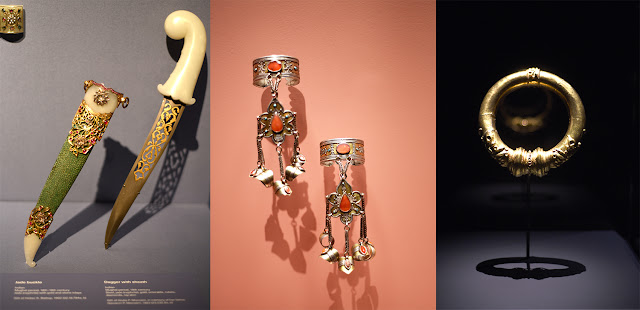Necklace elements (found near Bérchules, Alpujarra late 15th -16th century), part of Jewelry: The Body Transformed @METMuseum
Pretty and purposeful, "jewelry is defined primarily through its connection to and interaction with the body--extending it, amplifying it, accentuating it, distorting it, concealing it, or transforming it" [foreword to Jewelry: The Body Transformed]. No matter material or medium, sentiment is embodied in adornment. Opening November 12th, the MET Museum's Jewelry: The Body Transformed dissects the bejeweled significance of history, function, conviction and design in relation to ornamental pieces. Keep reading to see snaps from Monday's press preview...
Installation view in the introductory area
Over 200 objects divided among 6 areas illustrates the ubiquitous nature of jewelry across eras, cultures, manufacturing techniques, applications and costs. The exhibit opens with a darkened room; dramatic lighting spotlights an impressive arrangement--rows of artifacts clustered by applied body part (head and hair; nose, lips and ears; neck and chest; arms and hands; and waist, ankles and feet). Here, take note of a pair of gold earrings with Ganymede & the Eagle Hellenistic from around 330-300 BC, the crown of the Virgin of the Immaculate Conception (Crown of the Andes) from circa 1660-1770 and a headdress with phoenixes and flowers from the Ming Dynasty (16th-17th century).
Installation view of the Resplendent Body section
The remainder of the exhibit is sectioned into five thematic galleries featuring jewelry complemented by photographs, paintings, prints and sculpture. Divine Body links jewelry with immortality; an Egyptian ensemble used to transition the elite into the afterlife is a highlight. Resplendent Body explores techniques in jewelry making. Hints of history are present in Regal Body which showcases how jewelry personifies rank and status. As jewelry is made of the earth's resources, the Transcendent Body exemplifies the connection with spirituality and time. Lastly, pearls and woodblock prints illustrate how jewelry evokes sensual desire in Alluring Body.
The Bride Bedecked: [L]Thali (marriage necklace) Tamil Nadu (late 19th century) // [R] Jasmine-bud necklace (19th century)
Brilliant baubles and curatorial prowess draw parallels in jewelry's timeless aesthetic and meaning.From funerary ornaments to crafted headdresses, pieces crafted from gold to grass bask in the resplendence of their respective narratives.Worth the trip; the exhibit is available until February 24, 2019.
The Seductive Pearl: Five-strand pearl necklace (Cartier circa 1928)
[L] Seed pearl necklace (circa 1900) // [R] Seed pearl earrings (circa 1900)
[L] Ring of oxidized silver + rough diamonds (Karl Fritsch, 2005) // [M] Brass knuckles (Myra Mimlitsch-Grey, 1993) // [R] Ring w/name of Pope John Paul (Rome 1464-71)
Bejeweled Protectors: Installation view
Oh I Am Precious #7 necklace (Eugene & Hiroko Pijanowski 1986); made of straw!
[L] Earrings w/rhinestone bows (YSL 1983-84) // [R] Earrings w/dangling pendants (Korean circa end of 5th century)
Choker #70 (Mary Lee Hu, 1985)
[L] Jade Buckle + Dagger w/Sheath (circa 19th century) // [M] Bracelet w/attached rings (20th century) // [R] Neck ring (Celtic, circa 1st century BC)
[L] Earrings w/hanging pearls (Byzantine 6th-7th century) // [R] Necklace w/sapphire + pearl pendant crosses (Byzantine 6th-7th century)
Gold Egyptian sandals with toe stalls
[L] Enamel necklace w/opals and amethysts // [R] Incubus necklace (Simon Costin, 1987)
Gold Beads (Baule or Lagoon peoples, circa 19th to mid-20th century)
[L] Yashmak (Shaun Leane for Alexander McQueen) // [R] Necklace w/diamonds + pearls (Dreicer & Co. circa 1905)


















No comments:
Post a Comment